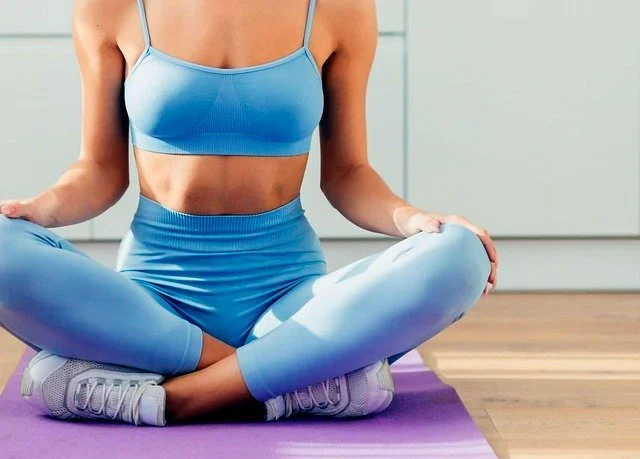Strong at the Core: The Deeper Power Behind Your Centre
You may remember admiring Jessica Ennis’s highly toned six-pack during the Olympic Games last year—perhaps even admitting to a little six-pack envy! A defined, muscular torso has become a modern symbol of strength and power. And as we spring into action this summer, it's worth considering just how important our core is in yoga—regardless of whether we’re rocking a six-pack or a one-pack.
But when we look beyond the physical aesthetics of a strong core, we uncover a deeper significance. The core doesn’t just provide strength and stability for the body—it is, in many Eastern traditions, the origin of our innermost guidance and wisdom.
Connecting with our centre allows us to tap into an intuitive support system that influences our movements and decisions, both on and off the mat. The benefits of core awareness expand far beyond the muscles—they reach into how we live, move, and feel.
Listening to the Body’s Rhythms
Recently, I treated a patient with acupuncture for acute back pain brought on by overstretching during a Pilates class. At a time when her body was asking for rest, she was pushing beyond her reserves—physically and energetically. It’s a familiar story in modern life, where the space to slow down or pull back can feel out of reach.
Just as nature ebbs and flows, so too does our energy. I’ve been reminded of this during my own yoga practice—especially on occasions when enthusiasm overrides sensitivity. That’s when my old shoulder injury starts to whisper… or shout!
Yoga as a Practice of Sustainability
Yoga teaches us to reconnect with our natural rhythms, especially through the breath. When we coordinate breath and movement—feeling the breath travel into the abdomen—we develop a greater sensitivity to the needs of our body.
This connection helps us recognise when we’re overextending, pushing too far, or depleting our energy. Just like a house that looks beautiful from the outside but wastes energy inefficiently, we too can appear strong while draining ourselves unnecessarily.
Developing a relationship with the core is like accessing an internal support system. It teaches us to conserve, adjust, and move in a way that’s sustainable over the long term.
Preservation Over Performance
These days, there’s growing awareness across many fields—especially sport—of the importance of sustainability over short-term gains. In professional sports, economy of movement is now seen as essential to long-term performance. There’s a stronger emphasis on injury prevention, rehabilitation, and body awareness.
Many football and rugby clubs now invest heavily in podiatry, physiotherapy, yoga, and acupuncture, recognising that strength and success often lie in the small details: a healthy spine, good foot alignment, strong muscle tone, a balanced diet—and crucially, rest.
Resting players to ensure longevity and fitness isn’t seen as a weakness—it’s strategic wisdom.
The Power of Doing Less
In a culture that prizes productivity and constant action, effort is often overvalued. But in Chinese philosophy, there is a concept called “wu wei”, which means "effortless action" or "non-forcing." It teaches that we don’t need to struggle to be effective; instead, we align with the energy available to us and move accordingly.
Nature follows this principle: eagles aren’t always soaring; waves rise and fall. When we pause or do a little less, our actions can become more focused, efficient, and energized. Likewise, developing core stability gives us a foundation from which we can move with more freedom and ease.
Moving From the Centre
In yoga, learning to move from the centre teaches us to sense how much or how little to extend. It helps us feel when to conserve energy, when to challenge ourselves, and when to wait patiently for muscles to open.
This quality of movement brings integrity, balance, and calm. It’s like recycling our energy—preserving it for when we truly need it—instead of constantly "down-cycling" into depletion.
In dance and martial arts, moving from the core creates effortless shifts in direction and weight. Experienced dancers and martial artists exhibit a natural grace—movement that begins from deep within, not from the outer limbs.
In traditional Chinese practices, the Dan Tian—a point just below the navel—is seen as the energetic centre of the body. It’s where the navel expands and contracts during deep abdominal breathing. Breathing this way calms the nervous system, reduces stress, and enhances vitality.
Return to the Centre
In all mindful movement forms, there’s a rhythm: a continual reaching out and returning inward. The extensions of the limbs are always supported by the core. The periphery expresses the inner self, the whole body working in concert.
A deeper connection with your core through yoga enriches your practice and brings greater awareness, safety, and efficiency to how you move—both on and off the mat.
Remember These Key Points in Your Yoga Practice:
Integrate breath with movement to develop body awareness
🧘♀️ Refine your alignment to create greater stability with minimal tension
🕊️ Don’t force movement—flow with your natural energy
Move from your centre—notice where the breath expands on inhalation
Trust your inner feedback—let your teacher know if something feels off
(e.g., discomfort, old injuries resurfacing, or restricted movement)


